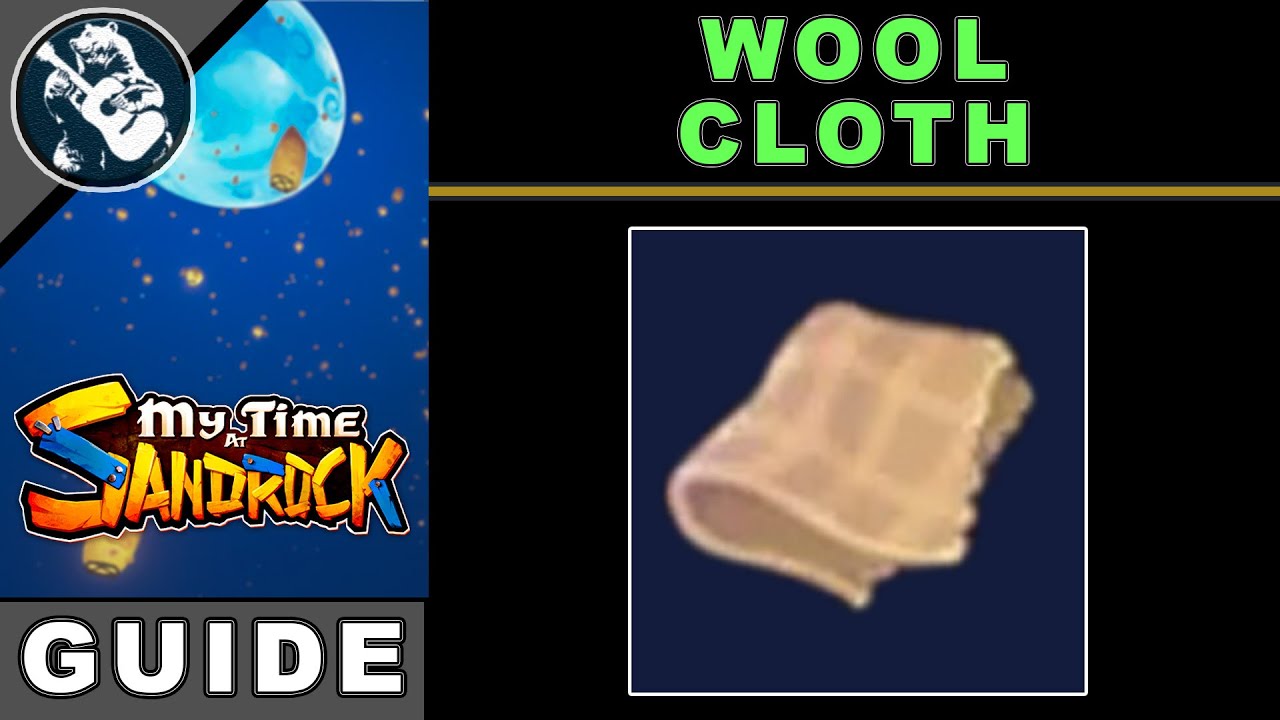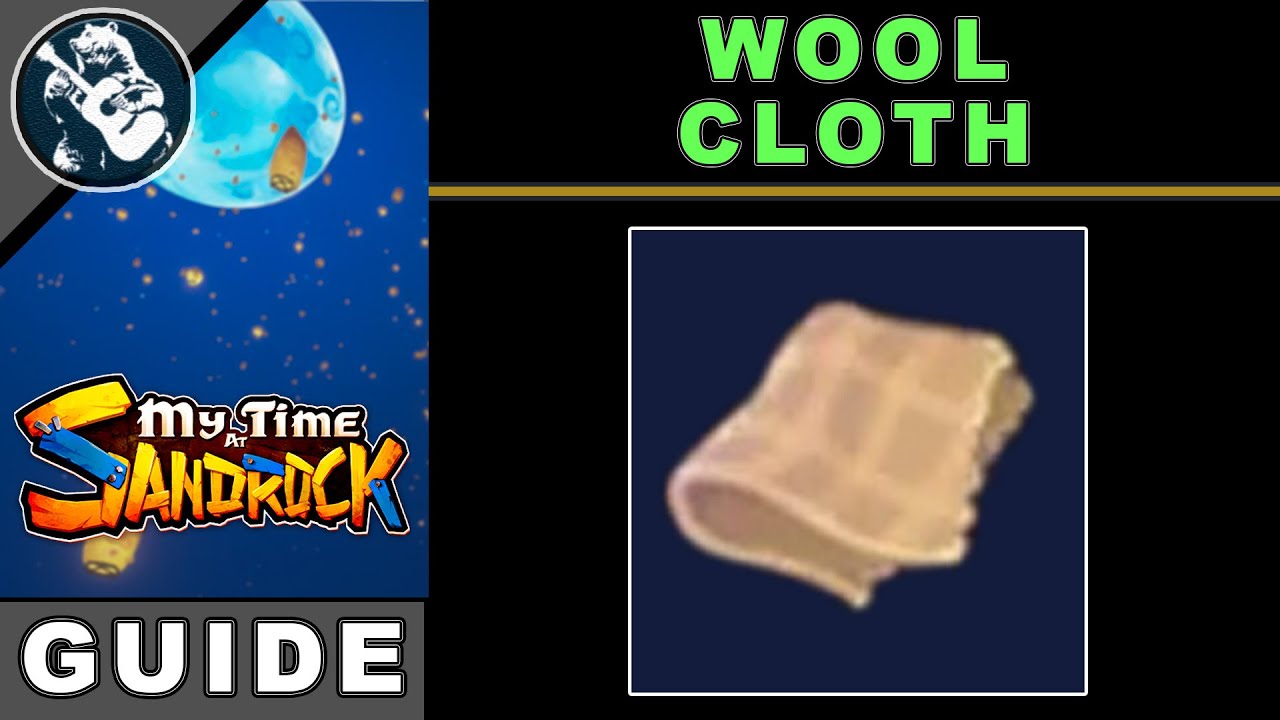My time at sandrock rough cloth – In My Time at Sandrock, rough cloth is an essential resource used in building, crafting, and trading. This comprehensive guide delves into the significance of rough cloth, its crafting process, market value, and its role in character development and interactions.
Crafting rough cloth requires specific materials and techniques. By understanding the process, players can optimize their production and maximize their resources. Rough cloth’s durability and value are influenced by its quality, which is determined by factors such as the materials used and the player’s crafting skills.
Introduction

My Time at Sandrock is a captivating sandbox role-playing game that transports players to the rugged and unforgiving desert town of Sandrock. This vibrant and immersive setting serves as a prequel to the critically acclaimed My Time at Portia, expanding upon the beloved world and introducing a host of new characters, challenges, and opportunities.
Rough cloth, a fundamental resource in My Time at Sandrock, plays a pivotal role in the game’s crafting and building systems. It is an essential component for creating a wide array of items, including clothing, tents, and even furniture. Rough cloth can be obtained through various methods, such as gathering fibers from plants or purchasing it from merchants in the town.
Obtaining Rough Cloth
Acquiring rough cloth in My Time at Sandrock requires a combination of exploration and resource management. Players can gather plant fibers from various locations around the town, such as the Abandoned Ruins and the Grasslands. These fibers can then be processed at a Loom to create rough cloth.
Alternatively, players can purchase rough cloth directly from merchants in Sandrock. This method is more convenient but may require a significant amount of in-game currency, known as Gols. The availability and price of rough cloth can fluctuate depending on the merchant’s inventory and the current market conditions.
Crafting and Usage
Crafting rough cloth in My Time at Sandrock involves a multi-step process that requires specific materials and tools. To begin, players must gather plant fibers, which can be obtained by harvesting plants like jute or cotton. These fibers are then processed into thread using a spinning wheel.
Once thread has been created, it can be woven into rough cloth using a loom.
The quality of rough cloth is determined by the quality of the plant fibers used in its creation. Higher-quality fibers will result in rough cloth with increased durability and value. Additionally, the player’s crafting skill level can also influence the quality of the rough cloth produced.
Uses of Rough Cloth
Rough cloth is a versatile material with numerous uses in My Time at Sandrock. It is primarily used in the construction of buildings, where it serves as a roofing material. Rough cloth can also be used to craft various items, including clothing, bags, and tents.
Additionally, rough cloth can be traded with other players or merchants for resources or currency.
Trading and Commerce
Rough cloth is a valuable commodity in My Time at Sandrock, used in various crafting recipes and building projects. Understanding the different ways to trade rough cloth, its market value, and strategies for maximizing profits is crucial for players.
Ways to Trade Rough Cloth
There are several ways to trade rough cloth in My Time at Sandrock:
- Selling to Traders:Players can sell rough cloth to various traders located in Sandrock. The price offered by traders varies depending on the trader and the current supply and demand.
- Setting Up a Stall:Players can set up a stall in their workshop to sell rough cloth directly to other players. This allows for greater control over pricing and the ability to negotiate with buyers.
- Trading with Friends:Players can trade rough cloth with friends or guild members to exchange resources or complete specific crafting tasks.
Market Value of Rough Cloth
The market value of rough cloth fluctuates based on supply and demand. When there is a high demand for rough cloth, such as during building projects or crafting events, its price will increase. Conversely, when there is an oversupply of rough cloth, the price will decrease.
Players can monitor the market value of rough cloth by checking the prices offered by traders or by observing the prices at which other players are selling it on their stalls.
Maximizing Profits
To maximize profits when trading rough cloth, players should consider the following tips:
- Sell During High Demand:Sell rough cloth when there is a high demand for it, such as during building projects or crafting events.
- Negotiate Prices:When selling to traders or other players, negotiate the price to get the best possible deal.
- Craft Items:Instead of selling raw rough cloth, consider crafting it into items that are in high demand, such as tents or backpacks, to increase its value.
Character Development and Interactions
In Sandrock, rough cloth is not merely a material but also a catalyst for character development and relationship-building. It serves as a tangible representation of the player character’s progress and their connections with others.
As the player character hones their weaving skills, their ability to craft higher-quality rough cloth improves. This not only unlocks new crafting opportunities but also earns them recognition and respect from the community. Rough cloth becomes a symbol of the character’s growing proficiency, a testament to their hard work and dedication.
Trading and Relationships
Trading rough cloth is not just a means of acquiring resources; it is also a social activity that fosters relationships and creates new opportunities. By exchanging rough cloth with other characters, the player character establishes connections and builds trust. These relationships can lead to valuable information, quests, and even romantic encounters.
- For example, trading rough cloth with the merchant Jasmine can unlock a quest to find a rare fabric for her shop. Completing this quest not only rewards the player with experience and resources but also strengthens their bond with Jasmine.
- Additionally, trading rough cloth with the blacksmith Owen can lead to a collaboration where the player character’s weaving skills are combined with Owen’s metalworking expertise to create unique and valuable items.
Quests and Storylines
Rough cloth is deeply intertwined with the quests and storylines of Sandrock. It is often a key item required to progress through certain quests, such as gathering a specific amount of rough cloth for a community project or using it as a bargaining chip in negotiations.
- In one storyline, the player character is tasked with uncovering a smuggling operation. Rough cloth is used as a codeword to identify smugglers and gain access to their hideout.
- Another quest involves the player character helping a group of refugees by providing them with rough cloth for shelter and clothing. By completing this quest, the player character not only contributes to the community but also earns the respect and gratitude of the refugees.
Challenges and Opportunities
Obtaining and using rough cloth in My Time at Sandrock presents several challenges for players. Firstly, rough cloth is a relatively rare resource, especially in the early stages of the game. Players must carefully manage their resources and prioritize the production of rough cloth over other items.
Secondly, rough cloth requires a significant amount of time and effort to produce. Players must first gather the necessary materials, such as cotton and thread, and then use a loom to create the cloth. This process can be time-consuming, especially if players are producing large quantities of rough cloth.
Overcoming Challenges
Despite these challenges, there are several ways that players can overcome them and take advantage of the opportunities that rough cloth provides. One strategy is to focus on increasing the production of cotton and thread. This can be done by upgrading the workshop and purchasing new equipment, such as a spinning wheel and a loom.
Another strategy is to trade with other players or NPCs for rough cloth. This can be a good way to obtain large quantities of rough cloth without having to spend time and effort producing it yourself.
Opportunities
Rough cloth can provide a number of opportunities for players who are willing to invest time and effort. One opportunity is to use rough cloth to create clothing and other items. These items can be sold for a profit or used to improve the player’s character.
Another opportunity is to use rough cloth to upgrade buildings and workshops. This can help to improve the player’s productivity and efficiency.
Comparison to Other Materials
Rough cloth, a readily available material in My Time at Sandrock, serves various purposes in crafting and construction. However, it has distinct characteristics compared to other materials, each with its advantages and disadvantages.
One notable comparison is with refined cloth. Refined cloth possesses superior durability and quality, making it ideal for crafting higher-tier items and garments. However, its scarcity and higher production cost limit its widespread use. Rough cloth, on the other hand, is more abundant and affordable, making it a practical choice for basic crafting needs and mass production.
Durability
- Refined cloth excels in durability, ensuring longer-lasting crafted items.
- Rough cloth, while less durable, provides adequate durability for basic applications.
Quality, My time at sandrock rough cloth
- Refined cloth boasts higher quality, resulting in more refined and aesthetically pleasing items.
- Rough cloth, while not as refined, offers a reasonable quality for everyday use.
Availability
- Rough cloth is widely available and easily acquired, making it accessible for most crafting projects.
- Refined cloth is scarce and requires more resources to produce, limiting its availability.
Cost
- Rough cloth is more affordable, making it a cost-effective option for large-scale production.
- Refined cloth is more expensive due to its higher quality and production requirements.
Ultimately, the choice between rough cloth and other materials depends on the specific requirements of the crafting project. For projects prioritizing durability, quality, and aesthetics, refined cloth is the preferred choice. However, for projects emphasizing affordability, accessibility, and mass production, rough cloth remains a viable and practical option.
Conclusion: My Time At Sandrock Rough Cloth
Rough cloth, as a fundamental resource in My Time at Sandrock, serves multiple purposes in the game’s economy and crafting system. Its versatility and accessibility make it a vital material for players throughout their gameplay experience.
Future updates and expansions could further explore the role of rough cloth in the game. For instance, introducing new crafting recipes or expanding the trading system could enhance the material’s significance and provide players with additional options for utilizing it.
Outlook on the Future of Rough Cloth
The future of rough cloth in My Time at Sandrock appears promising. As the game continues to develop, the material is likely to remain an essential component of the crafting and trading systems. Additionally, future updates could introduce new ways to obtain and utilize rough cloth, further enhancing its value and versatility.
Ultimate Conclusion
In conclusion, rough cloth is a versatile and valuable resource in My Time at Sandrock. Whether used for building, crafting, or trading, understanding its properties and uses empowers players to make informed decisions and progress efficiently in the game. As the game evolves, the role of rough cloth may expand, offering new opportunities for players to engage with this essential material.
FAQ Compilation
What are the materials required to craft rough cloth?
Rough cloth is crafted using plant fibers, which can be obtained by harvesting plants or purchasing them from traders.
How can I improve the quality of rough cloth?
The quality of rough cloth is influenced by the quality of the plant fibers used and the player’s crafting skills. Using higher quality fibers and improving crafting skills will result in higher quality rough cloth.
Where can I sell rough cloth?
Rough cloth can be sold to various traders in the game. The market value of rough cloth fluctuates based on supply and demand, so selling it at the right time can maximize profits.

